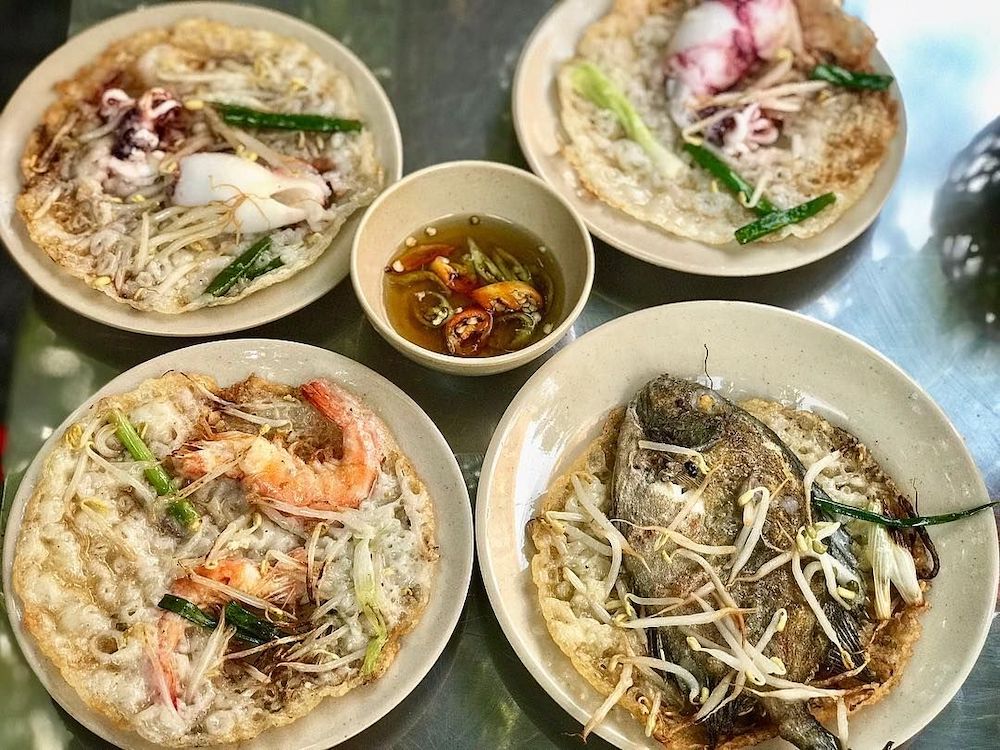Huế’s Bánh Xèo – Challenging at First, Addictive After

Bánh Xèo – A Dish, A Dozen Regional Stories
Bánh xèo – which literally means “sizzling pancake” – is more than just a dish. It’s a symbol of Vietnam’s diverse regional cultures, a culinary canvas that varies beautifully from one province to another. Each city has its own version, shaped by local ingredients, climate, and traditions.
At its core, bánh xèo is like a “dry hotpot”: you can add any topping you want – shrimp, pork, squid, fish, even mushrooms or beansprouts. It’s often a family-centered dish where people gather to prepare, cook, and enjoy together. The entire process becomes a shared experience that brings people closer. Just like hot pot gatherings, bánh xèo parties are also quite common—especially on hot days.
Origins: Myth, History, and a Central Vietnamese Heart
There’s no consensus on exactly where bánh xèo originated, but there are three main stories:
- Some say it came from the ancient Champa people.
- Others believe it was derived from bánh khoái, a royal dish from the Nguyễn dynasty in Huế.
- Another theory traces it back to the Tây Sơn army, who needed quick, nourishing food while on the move.
While its exact origins remain a mystery, one thing is clear: bánh xèo was born in Central Vietnam, where its most unique and boldest versions are still found today.
Bánh Xèo in the South: From Unknown to Street Staple
According to sources like VnEconomy, bánh xèo didn’t gain popularity in Saigon until the 1980s. During this time, waves of Central Vietnamese migrants brought the dish with them, wrapped in banana leaves as a convenient meal to eat on the go or in the fields. Over time, its affordability and flavor won over locals, making it a southern favorite.
Bánh Xèo Across Vietnam: A Journey Through Regional Variations
Southern Style – Big, Bold, and Coconut-Laced
This is the most popular version across Vietnam. The batter includes rice flour, turmeric, and coconut milk, creating large, crispy pancakes fried in wok-sized pans with the batter spread very thin. Filled generously with shrimp, pork belly, and bean sprouts, they’re served with heaps of herbs and sweet-sour fish sauce.
Mini Coastal Versions – Crisp and Hot
In southern coastal towns like Ninh Thuận and Bình Thuận, bánh xèo comes in miniature forms, cooked in a cast-iron pan with small round molds – similar to how Yorkshire puddings are made. The batter is poured into hot oil-filled molds, resulting in bite-sized, crispy pancakes with local seafood or quail eggs.
Same dipping sauce as in the South, but made lighter, so when dipped, this banh xeo—thanks to its structure—soaks up more of the sauce than regular bánh xèo, creating a bite that’s both crispy, tender, and juicy.
Central Style – Small, White, and Intensely Flavorful
In Central Vietnam, the batter is usually white (no turmeric), with little or no tapioca starch. The pancakes are smaller, batter is poured thicker than in Southern-style (just slightly thicker, not 2-3 cm like the mini coastal version) , resulting in a crispy outer layer and a thick, sauce-soaked interior., and often cooked in more oil. Each province adds its own little twist:
- Phú Yên: Pancakes are saltier, and a special sauce is made from tomato and pineapple puree, mixed with local mắm nêm (fermented anchovy sauce). A secret recipe from experienced street vendors!
- Quảng Bình: instead of regular rice flour, the key difference is that they use only brown rice flour - a local specialty of the region.
Image 1 : Mini Coastal Versions – Crisp and Hot

Huế, a region with two types of bánh xèo: one that’s easy to enjoy, and another that’s more of an acquired taste—but once you fall for it, you’re hooked.
- Bánh xèo cá kình (rabbitfish): Originating from the brackish lagoons of Đầm Chuồn, this version uses fresh local rabbitfish, paired with baby mustard greens and a special fish sauce made from “ruốc” (tiny fermented shrimp) and green chili from Huế.
The difference lies in the dipping sauce—it’s pure fermented sauce and Hue's signature green chillies, not mixed with the usual sweet-and-sour blend like elsewhere. And the fermented shrimp sauce isn’t for everyone—it’s like Marmite: you either love it or hate it. Some Locals say it’s too intense, too salty, while others are absolutely obsessed with it. And in my opinion, it pairs incredibly well with the mild bitterness of baby mustard greens. Some who enjoy bitter flavors even add the liver of rabbitfish, creating a uniquely bold taste that’s both bitter and deeply umami.
In addition to pairing with fish, they also enjoy it with baby squid—a local delicacy. Unlike regular squid, there's no need to remove the ink sac during cooking, as its ink blends into the bánh xèo, adding a surprisingly sweet depth of flavor.
- Bánh khoái: A A version that originated from the royal court of Huế, made with rice flour mixed with egg yolk, often filled with shrimp and the perfect bánh khoái has to be crispy, crackling, and crunchy—with that unmistakable “rụm rụm rụm” bite., and served with a dense and flavorful peanut dipping sauce.
It may sound greasy and rich—almost overwhelming—but that’s balanced out beautifully with slices of sour starfruit and raw fig. Their tangy freshness cuts through the richness of the sauce, not only neutralizing the heaviness but actually elevating it. And dont forgot to order a dish of Chảo Lụi too.
More Than a Meal – A Taste of Vietnamese Togetherness
Whether in the Mekong Delta or the banks of the Perfume River, bánh xèo always brings people together. It’s a dish that speaks of local identity, resourcefulness, and communal joy. Each crackle of the batter, each fresh herb wrap, tells a story — of the land, of the people, and of a culinary tradition passed through generations.
Image 2 : Rabbitfish Banh xeo and Baby Squid Banh xeo of Chuon Lagoon



